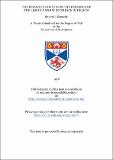Files in this item
The behaviour of ions in the presence of the liquid vapour interface in helium
Item metadata
| dc.contributor.advisor | Allen, J. F. | |
| dc.contributor.author | Kennedy, Stuart G. | |
| dc.coverage.spatial | 125 p. | en_US |
| dc.date.accessioned | 2018-06-28T08:13:45Z | |
| dc.date.available | 2018-06-28T08:13:45Z | |
| dc.date.issued | 1972 | |
| dc.identifier.uri | https://hdl.handle.net/10023/14677 | |
| dc.description.abstract | The thesis is concerned with some of the properties of positive and negative ions in liquid Helium, and in particular with the passage of ions, which are generated inside the liquid, through the free liquid surface into vapour. It was found, for negative ions, that this process was inhibited by an energy barrier, in agreement with other workers who have examined this problem, although there is considerable disagreement as to the magnitude of the barrier. It has been observed in the present work that the energy barrier depends upon the field, the position of the liquid surface in an ion cell, and the nature of the ion cell itself. The dependence of the barrier on these three parameters probably explains why diverse values for it have been reported. It was originally intended to use the ions as probes to examine dissipation mechanisms in the mobile superfluid Helium film. It had been reliably reported that ions preferentially travelled in the film. This was observed not to be the case however. The negative ion currents sin the film were found to be extremely small, when they existed at all, and no real positive ion currents in the film could be detected. This has been interpreted as being due to the combination of the large image potential binding the ion to the substrate, and the intrinsic roughness of the substrate. The present work has revealed that what appears at first sight to be a current of positive ions crossing the liquid surface can be attributed to a current of photoelectrons due to photoelectric emission from the surface of the collector. Such photoemission can arise from the uv radiation produced largely by ionic recombination in the region close to the a-emitting source. Screening the collector from the direct view of the a-source greatly reduced the photoelectron current. In order to extend the temperature range available, for the study of ion currents, a vortex refrigerator was designed and constructed. This enabled measurements to be extended down to 0.8K. Since there has been only one publication on the vortex refrigerator, which appeared during the building of the present one, its properties and operation with various design parameters were studied in detail. | en_US |
| dc.language.iso | en | en_US |
| dc.publisher | University of St Andrews | |
| dc.subject.lcc | QC717.K4 | |
| dc.subject.lcc | Ion flow dynamics | en |
| dc.title | The behaviour of ions in the presence of the liquid vapour interface in helium | en_US |
| dc.type | Thesis | en_US |
| dc.type.qualificationlevel | Doctoral | en_US |
| dc.type.qualificationname | PhD Doctor of Philosophy | en_US |
| dc.publisher.institution | The University of St Andrews | en_US |
This item appears in the following Collection(s)
Items in the St Andrews Research Repository are protected by copyright, with all rights reserved, unless otherwise indicated.

